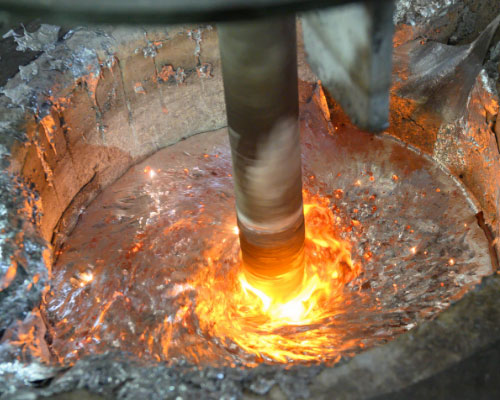Gas purification is the main primary aluminum purification method. The gas used is chlorine, nitrogen, or a mixture of chlorine and nitrogen.
(1) Chlorine purification. In the chlorination method, when chlorine gas is passed into the aluminum liquid, many abnormally fine AlCl3 bubbles are generated and are fully mixed in the aluminum liquid. The hydrogen dissolved in the molten aluminum and some mechanical inclusions are adsorbed on the bubbles and are discharged as the bubbles rise to the surface of the molten aluminum. When chlorine gas is introduced, some elements that are more negatively charged than aluminum can be chlorinated, such as calcium, sodium, magnesium, etc., which are separated into corresponding chlorides due to the introduction of chlorine gas. Therefore, the chlorination method is a very effective primary aluminum purification method. The amount of chlorine gas is 500~700g per ton of aluminum, but because chlorine gas is toxic and relatively expensive, in order to avoid air pollution and reduce the cost of aluminum ingot production, the third-generation aluminum industry has gradually abolished the chlorination method and changed it to inert gas. -Nitrogen purification method.
(2) Nitrogen purification method. N2 is directly passed into the molten aluminum, the molten aluminum continuously enters the casting platform, and is flushed by nitrogen, so the metal inclusions and dissolved hydrogen in the molten aluminum are removed, so that the fine nitrogen bubbles are evenly distributed in the treated molten aluminum. Degassing with Nitrogen plays the role of purification. Nitrogen has no pollution to the atmosphere and has a large purification capacity. It can process 200 to 600 kg of aluminum liquid per minute. The amount of aluminum loss caused during the purification process is relatively reduced, so it is now widely used, but it is not as capable of removing the aluminum liquid as chlorine. Calcium, sodium, magnesium.

(3) Mixed gas purification. A mixture of chlorine and nitrogen is used to purify the aluminum liquid. Its role is to remove hydrogen and separate oxides on the one hand, and to remove certain metal impurities (such as Mg) in aluminum on the other. The commonly used composition is 90% nitrogen + 10% chlorine. . There are also 10% chlorine mixed with 1% carbon dioxide and 80% nitrogen. This effect is better, carbon dioxide can diffuse chlorine and nitrogen well, which can shorten the operation time.

